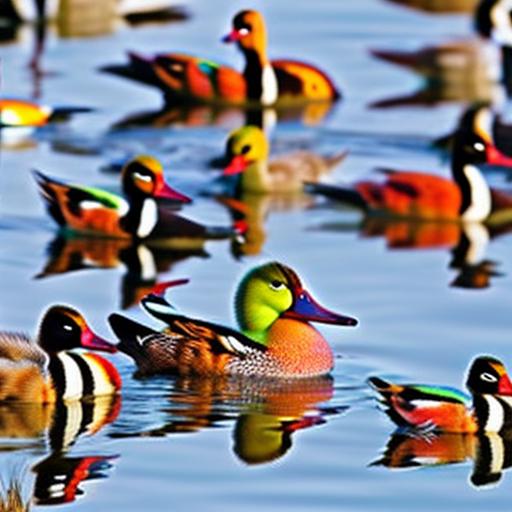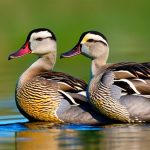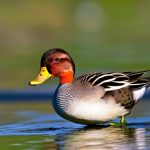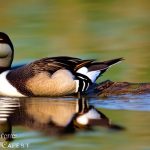Colorful duck breeds are a unique and fascinating group of ducks that are known for their vibrant and eye-catching plumage. Unlike their more common counterparts, these ducks come in a wide range of colors and patterns, making them a popular choice for both hobbyists and farmers alike. From the striking Mallard to the elegant Mandarin, colorful duck breeds offer a visual feast for the eyes.
What makes colorful duck breeds particularly interesting is their diversity in appearance. While most ducks are known for their plain and muted colors, these breeds break the mold with their bold and vibrant feathers. Whether it’s the iridescent green head of the Mallard or the intricate patterns of the Indian Runner, these ducks are sure to capture attention wherever they go.
Key Takeaways
- Colorful duck breeds are a unique and diverse group of ducks that are popular among farmers and hobbyists alike.
- Some of the most popular colorful duck breeds include the Indian Runner, the Mallard, and the Muscovy.
- Characteristics of colorful duck breeds include a wide range of colors and patterns, as well as unique physical features like crests and tufts.
- The history of colorful duck breeds dates back centuries, with many breeds originating in Asia and Europe.
- Breeding and raising colorful duck breeds requires careful attention to their specific needs, including diet, housing, and health care.
The Most Popular Colorful Duck Breeds
1. Mallard: The Mallard is perhaps one of the most well-known and recognizable duck breeds. The male Mallard features a striking green head, yellow bill, and a chestnut-colored breast. The female Mallard, on the other hand, has a mottled brown plumage that provides excellent camouflage.
2. Mandarin: The Mandarin duck is famous for its stunningly beautiful plumage. The male Mandarin has a vibrant combination of orange, green, and blue feathers, while the female has a more subtle but equally elegant appearance with her grayish-brown feathers.
3. Indian Runner: The Indian Runner duck is known for its unique upright stance and slender body shape. This breed comes in a variety of colors, including white, black, fawn, and chocolate. Their distinctive appearance and comical running gait make them a favorite among duck enthusiasts.
Characteristics of Colorful Duck Breeds
Colorful duck breeds not only stand out visually but also possess unique physical and behavioral characteristics.
1. Physical characteristics: These ducks often have vibrant plumage that can range from solid colors to intricate patterns. They may also have distinctive features such as crests, tufts, or unique bill shapes. Additionally, colorful duck breeds come in various sizes, with some being larger and more robust than others.
2. Behavioral characteristics: Colorful duck breeds are known for their active and social nature. They enjoy foraging for food, swimming, and interacting with other ducks. Some breeds, like the Indian Runner, are particularly known for their upright stance and ability to run rather than waddle.
The History of Colorful Duck Breeds
The history of colorful duck breeds can be traced back to ancient times when humans began domesticating ducks for various purposes. Over time, selective breeding led to the development of ducks with unique and vibrant plumage.
The Mallard, for example, is believed to be one of the oldest domesticated duck breeds. It has been bred for centuries for its meat and eggs but also for its striking appearance. The Mandarin duck, native to East Asia, has a long history of being kept as ornamental birds in Chinese gardens.
As for the Indian Runner duck, it is believed to have originated in the East Indies and was brought to Europe in the 19th century. Its distinctive upright stance and ability to run quickly made it a popular choice for farmers who needed ducks that could efficiently forage for food.
Breeding and Raising Colorful Duck Breeds
Breeding and raising colorful duck breeds can be a rewarding experience but requires careful planning and consideration.
1. Tips for breeding: When breeding colorful duck breeds, it’s important to select healthy and genetically diverse individuals to ensure strong offspring. Provide a suitable nesting area and monitor the breeding process closely. It’s also essential to provide proper nutrition and ensure that the ducks have access to clean water.
2. Tips for raising: Raising colorful duck breeds requires providing them with a suitable living environment that includes a secure enclosure and access to water for swimming. Ducks are social animals, so it’s important to keep them in pairs or small groups. Additionally, provide a balanced diet that includes a mix of grains, vegetables, and protein.
Unique Features of Colorful Duck Breeds

Colorful duck breeds have several unique features that set them apart from other ducks.
1. Crests and tufts: Some colorful duck breeds, such as the Crested and Tufted ducks, have distinctive crests or tufts on their heads. These features add an extra level of visual interest and make them stand out in a crowd.
2. Bill shapes: Certain colorful duck breeds, like the Muscovy duck, have unique bill shapes. The Muscovy duck has a fleshy caruncle on its face, giving it a distinctive appearance.
3. Patterns and colors: Colorful duck breeds come in a wide range of patterns and colors, from solid hues to intricate markings. This diversity allows for endless possibilities when it comes to selecting ducks for breeding or as pets.
The Importance of Colorful Duck Breeds in Agriculture
Colorful duck breeds play an important role in agriculture and the ecosystem.
1. Pest control: Ducks are natural foragers and can help control pests such as snails, slugs, and insects in agricultural settings. Their feeding habits can reduce the need for chemical pesticides, making them an eco-friendly option for pest control.
2. Manure production: Ducks produce nutrient-rich manure that can be used as fertilizer for crops. Their droppings are high in nitrogen and other essential nutrients, making them an excellent natural fertilizer.
3. Genetic diversity: Colorful duck breeds contribute to genetic diversity within the duck population. This diversity is crucial for maintaining healthy and resilient populations that can adapt to changing environmental conditions.
Health and Care of Colorful Duck Breeds
Keeping colorful duck breeds healthy requires proper care and attention.
1. Housing: Provide a secure and spacious enclosure for your ducks that protects them from predators and the elements. Ducks also need access to clean water for swimming and bathing.
2. Nutrition: Offer a balanced diet that includes a mix of grains, vegetables, and protein. Ducks also require access to fresh water at all times.
3. Veterinary care: Regularly monitor your ducks for signs of illness or injury. Consult with a veterinarian experienced in avian care if you notice any health issues.
Colorful Duck Breeds for Exhibition and Show
Colorful duck breeds are often showcased in exhibitions and shows, where their unique features and plumage are judged.
1. Preparation: Before exhibiting your ducks, ensure they are in optimal health and condition. Groom their feathers, trim their nails, and clean their feet to present them at their best.
2. Judging criteria: Judges typically look for ducks with vibrant and well-defined plumage, correct body shape, and overall health and vitality. Each breed has specific standards that judges use as a guideline for evaluation.
The Beauty and Diversity of Colorful Duck Breeds
Colorful duck breeds offer a unique and visually stunning addition to any flock or farm. Their vibrant plumage, distinctive features, and diverse characteristics make them a fascinating choice for both hobbyists and farmers alike. Whether you’re looking for a striking ornamental bird or a practical addition to your agricultural endeavors, colorful duck breeds are sure to captivate with their beauty and diversity.
If you’re interested in colorful duck breeds, you might also want to check out this informative article on Poultry Wizard about the different types of coops that are best for chickens. Having a suitable coop is essential for the well-being and safety of your poultry. Understanding how big a coop needs to be for a chicken and what kind of coop is best can help ensure that your feathered friends have a comfortable and secure living space. To learn more, visit https://poultrywizard.com/keeping-chickens/what-kind-of-coop-is-best-for-chickens/.
FAQs
What are colorful duck breeds?
Colorful duck breeds are domesticated ducks that have unique and vibrant plumage. These ducks come in a variety of colors and patterns, including blue, green, black, white, and brown.
What are some examples of colorful duck breeds?
Some examples of colorful duck breeds include the Mandarin duck, the Wood duck, the Cayuga duck, the Indian Runner duck, and the Rouen duck.
What is the purpose of breeding colorful ducks?
Breeding colorful ducks is often done for ornamental purposes, as these ducks are prized for their unique and eye-catching appearance. Some breeds may also be raised for their meat or eggs.
Are colorful duck breeds easy to care for?
Colorful duck breeds require the same basic care as other domesticated ducks. They need access to clean water, a balanced diet, and a safe and secure living environment. Some breeds may require additional care, such as regular grooming or specialized diets.
Can colorful duck breeds be kept as pets?
Yes, many colorful duck breeds make excellent pets. They are social animals that enjoy interacting with their owners and can be trained to do simple tricks. However, it is important to research the specific breed before bringing a duck home, as some breeds may require more space or specialized care than others.
Where can I buy colorful duck breeds?
Colorful duck breeds can be purchased from breeders, hatcheries, or online marketplaces. It is important to choose a reputable seller and to ensure that the ducks are healthy and well-cared for before making a purchase.
Meet Walter, the feathered-friend fanatic of Florida! Nestled in the sunshine state, Walter struts through life with his feathered companions, clucking his way to happiness. With a coop that’s fancier than a five-star hotel, he’s the Don Juan of the chicken world. When he’s not teaching his hens to do the cha-cha, you’ll find him in a heated debate with his prized rooster, Sir Clucks-a-Lot. Walter’s poultry passion is no yolk; he’s the sunny-side-up guy you never knew you needed in your flock of friends!







